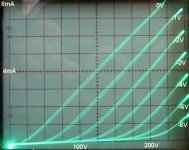I notice some slightly doubled up lines for each curve. Some tube hysteresis factor or capacitance in the test setup maybe? Someone even mentioned recently an article by Norman Crowhurst about the absolute limitations of VT amplification accuracy due to vaccum tube hysteresis. But those doubled up lines look a bit too perfect for that.
And the clean separation of the curves at the bottom don't look like typical tube curves.
Some Mosfet contraption likely.
And the clean separation of the curves at the bottom don't look like typical tube curves.
Some Mosfet contraption likely.
Last edited:
Hello,
Perfectly linear? No! The curves look straight, however they stack up (get closer together) from left to right. That means variable mu and not perfectly linear.
DT
All just for fun!
Perfectly linear? No! The curves look straight, however they stack up (get closer together) from left to right. That means variable mu and not perfectly linear.
DT
All just for fun!
Ok, it's not perfectly linear, but it's pretty good right?
The doubled curves are mainly due to my curve tracer which uses half-wave rectification, so no doubt suffers some core hysteresis.
And I promise it is a real valve, not a MOSFET!
The doubled curves are mainly due to my curve tracer which uses half-wave rectification, so no doubt suffers some core hysteresis.
And I promise it is a real valve, not a MOSFET!
other than doubled lines looks pretty darn good - what's its safe plate dissipation? is it made from a pentode?
Mu somewhere in the mid 30's. Whats diff between this and 6dj8?
Actually transconductance is far less than 6dj8, so maybe 6N1P?
No, not even that good. What is this? Mini or nuvistor?
Slightly Schaded 12AX7?
Actually transconductance is far less than 6dj8, so maybe 6N1P?
No, not even that good. What is this? Mini or nuvistor?
Slightly Schaded 12AX7?
Last edited:
Ok, it's not perfectly linear, but it's pretty good right?
Looks like ECC83 and yes, they look fairly good.
That's a pretty good approximation to an ideal triode, which is a voltage-controlled voltage source with series resistance Rp.
Curiously, the triode is the only amplifying device known with an effective voltage source inside, though it's usually a pretty bad source in the greater scheme of things (Rp in kohms).
Tim
Curiously, the triode is the only amplifying device known with an effective voltage source inside, though it's usually a pretty bad source in the greater scheme of things (Rp in kohms).
Tim
Keep trying! There are no added feedback resistors or anything, its just plugged straight into my curve tracer.
Hi,
Next shot....
Could it be a VT4C or 211?
One thing I'm sure of, there more than a few triodes with similar linearity out there.
Cheers, 😉
Next shot....
Could it be a VT4C or 211?
One thing I'm sure of, there more than a few triodes with similar linearity out there.
Cheers, 😉
Mu is about 32. Transconductance is 1500umho. Plate resistance is ~25k. So it's not a 12AX7/ECC83. Could be triode-connected EF86?
What do you think of this for a near-perfect linear triode?
I think I'll copy SY and let you guess what it is!
Do you mean this right-handed one?

- Status
- Not open for further replies.
- Home
- Amplifiers
- Tubes / Valves
- Could this be a perfectly linear triode?
